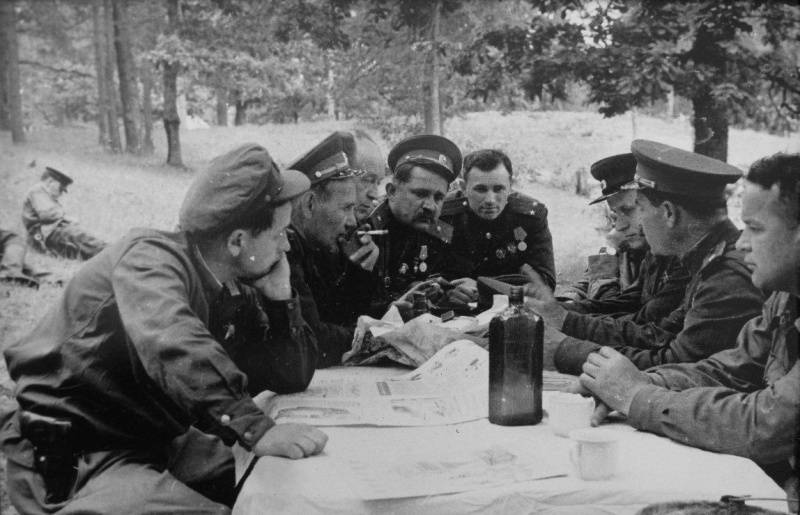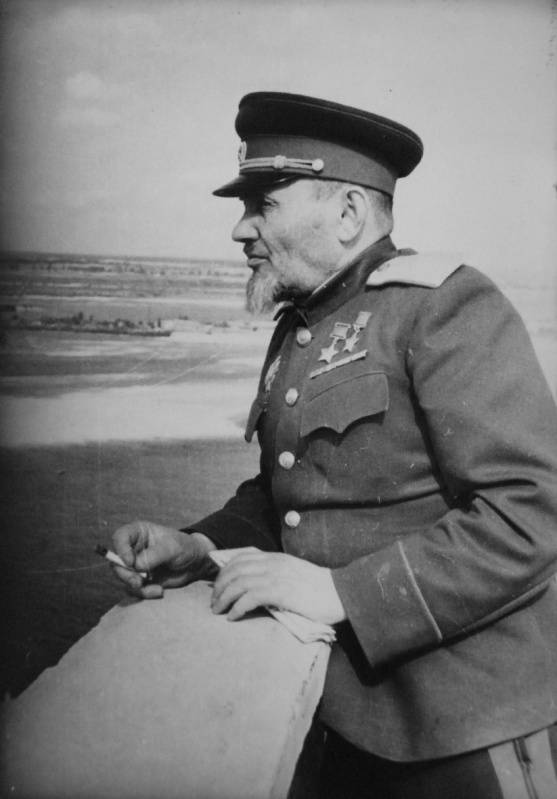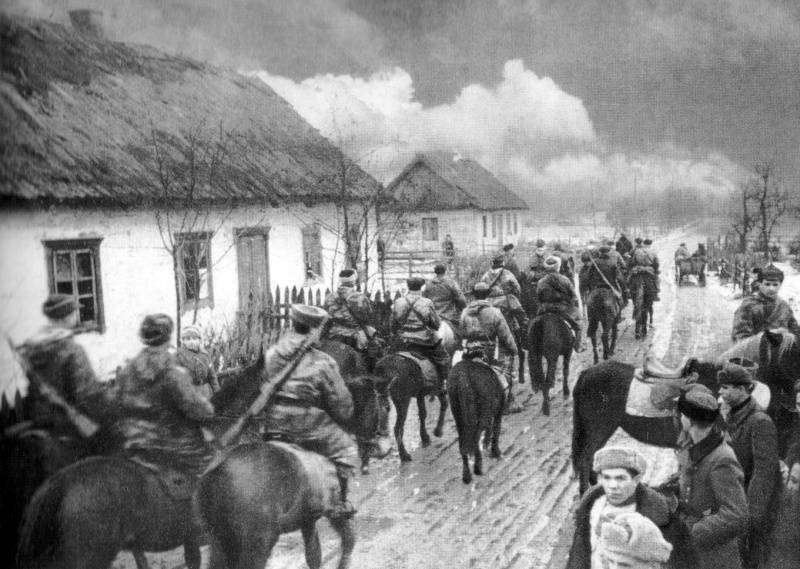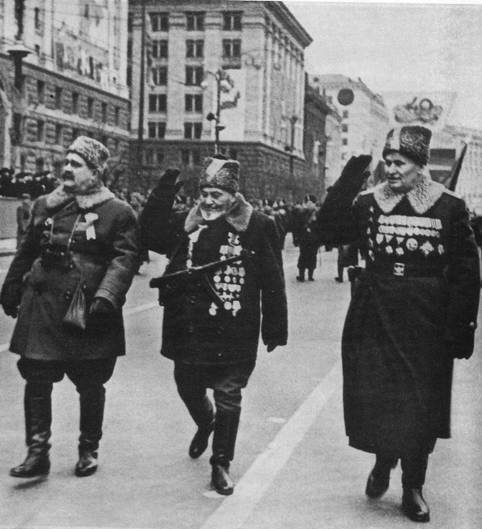Legendary Partisan General Sydor Kovpak
Before the Great War
Sydor Artemyevich (Artyomovich) Kovpak was born on May 26 (June 7) 1887 in the village of Kotelva (now a urban-type settlement in the Poltava region of Ukraine) in a poor large peasant family. From childhood, he helped his parents with the housework, like any peasant, he worked from morning to evening. At ten, he began working for a local shopkeeper. Primary education received in the parish school. Sydor learned about the war from his grandfather Dmitro, who lived 105 for years, was an old soldier of the Nicholas era, fought in the Caucasus and near Sevastopol.
Military service began in Saratov in the Alexander Regiment. After the service he worked there, in Saratov, as a loader. With the beginning of the First World War, Kovpak was mobilized into the army, as part of the 186 Infantry Regiment of Aslanduz. He fought on the South-Western Front, was a member of the famous Brusilovsky breakthrough. Sidor Artemyevich stood out among the other soldiers with his wit and the ability to find a way out of any situation. No wonder he became a scout. In battles and sorties he was wounded several times. In the spring of 1916, Tsar Nicholas II, who personally came to the front, awarded Sidor Kovpak with two medals “For Bravery” and St. George crosses of III and IV degrees.
After the start of the revolution, Kovpak supported the Bolsheviks. In 1918, Sidor took an active part in the struggle for the power of the Soviets, headed the land commission for the distribution of landowner lands among the poor peasants. He became the organizer of the partisan detachment, who fought against the regime of Hetman Skoropadsky, fought with the German-Austrian invaders, and then, united with the fighters of the famous Lugansk Bolshevik Alexander Parkhomenko, with Denikin. In 1919, when his detachment fought Ukraine, Kovpak decides to join the Red Army. As part of the 25-th Chapayev Division, where he commanded a platoon of machine-gunners, Sidor Artemyevich fought first on the Eastern Front, and then on the Southern with General Denikin and Wrangel. For his courage, he was awarded the Order of the Fighting Red Banner.
After the end of the Civil War, Kovpak was a military commissioner, engaged in economic work. In 1921-1926 - Assistant to the district military commissar, district military commissar, military commissar of the Pavlograd district of the Yekaterinoslav province (Dnipropetrovsk region). Simultaneously in 1925-1926 - Chairman of the Agricultural Artel in the village of Verbki. In 1926, he was elected director of the military-cooperative economy in Pavlograd, and then chairman of the Putivl agricultural cooperative. After the approval of the Constitution of the USSR 1936, Sidor Artemyevich was elected deputy of the City Council of Putivl, and at its first meeting in 1937, he was elected Chairman of the Putivl City Executive Committee of the Sumy Region. In a peaceful life, he was distinguished by exceptional diligence and initiative.
Kovpak himself proudly recalled how he bloomed his homeland in the peaceful Soviet years: “During the years of Soviet power, the Putyvl district came from the area of seasonal migrant workers, who were leaving in the spring in search of earnings all over Ukraine and Russia, from the consuming, provincial backwater region, where they lived retired officials and officer widows, turned into an area producing, famous for collective millionaires - participants of the All-Union Agricultural Exhibition, collective farms having several cars, their hydroelectric stations, clubs, average schools, dispensaries. We have achieved crops, which we could not even dream of here. What kind of trotters of the Oryol breed were raised by collective farm horse-breeding farms in Strelniki, Litvinovich, Vorgol! What herds of pedigree dairy cattle grazed on the water meadows on the Diet! And our orchards! We need to visit us when the apple and cherry trees are blooming. The whole city, all the villages as if in the clouds, only the rooftops are visible. We had a lot of honey, and there were so many geese that it seemed that the summer snow lay on a meadow near the Sejm under a former monastery. Yes, Ukraine flourished under the Soviet regime, it was something to be proud of us, its sons, the Ukrainian Bolsheviks, who built a free and happy life in their native land. ”
Unfortunately, the war soon came, and a lot of things were ruined, and after the victory, the Soviet people had to repeat the great feat, restoring the already destroyed.

The commander of the 1-th Ukrainian partisan division Sidor Artemyevich Kovpak (second left) at a meeting with headquarters. On the fourth photo from the left - Commissar of the 1-th Ukrainian partisan division, Major General Semyon Rudnev
Guerrilla commander
In September, 1941, when the German troops approached Putivl, Sidor Artemyevich, who was already 55 years old at the time, together with his comrades decided to create a partisan detachment in the nearby Spadshchansky forest area. Kovpak and his comrades in advance organized a warehouse with food and ammunition. Initially, the detachment was about four dozen fighters. They identified scouts, miners, the rest were divided into two battle groups. In one, the authorities, civilians and mostly elderly, Soviet and party workers, collective farm assets. So, among them was Alexey Ilyich Kornev, who received the nickname Father Frost for his snow-white beard and lush head of hair. Before the war, he was engaged in brooding chickens - he ran an incubator in Putivl. In another group - the military, lagged behind their parts, caught in the environment. Kovpak immediately established control over the forest, in the directions from which one could expect the appearance of the Germans, outposts were advanced. With the neighboring collective farms, communications were established, collective farmers, risking their lives (for communication with the partisans, the Germans executed), delivered information, helped with supplies. They discovered a minefield that the retreating Red Army had left, mines were removed under the Germans' nose, they were installed on the main roads. As Kovpak noted, by the middle of October, about a dozen trucks with ammunition and manpower had been blown up on these roads. And the partisans took ten thousand rounds. But with weapons it was bad, even the rifles were not enough. September 29 was the first fight - the guerrillas drove away the German foragers-procurers.
October 18 was joined by a detachment led by Semyon Rudnev, who became Kovpak’s closest friend and ally during the Great War. Rudnev also had a great combat experience — a participant in the October Revolution and the Civil War; before World War II, he served as the head of the political department and commissar of the coastal defense forces of the De-Kastrinsky fortified area in the Far East. In 1939, for health reasons, he demobilized from the army and returned to Putivl. After the outbreak of war, he also formed a partisan detachment. Grigori Yakovlevich Bazim, the ensign of the old Russian army, the best teacher in the region, the delegate of the first all-Union congress of teachers was appointed the chief of staff of the united detachment. As a result, the Kovpak squad rises to 57 man and becomes quite combat-ready in armed clashes with the enemy, although initially there was a shortage of weapons. Kovpak for himself personally declares war on the Nazis "to the bitter end."
On October 19, 1941, the Germans tried to clear the Spadshchansky forest from the partisans. Two were sent to the forest tankHowever, the operation failed. The partisans were not afraid, they did not run. One tank damaged the track and got stuck. The Germans moved into another tank and tried to retreat, but were blown up by a mine and died. On December 20, the Germans repeated their attempt to destroy the partisans - a large detachment was sent from Putivl. Scouts counted 5 tanks, one wedge heel and 14 vehicles with infantry. The tanks stopped in the field and opened fire on the forest, fired at random, therefore without success. Then, having divided into two groups, they went forward, but ran into mines and retreated.
Thus, Spadshchansky forest turned into an autonomous fortress. Scouts and collective farmers warned about everything that was done in Putivl. But the Germans did not know anything about the forest detachment - neither about the location of the detachment, nor its forces. Spies who tried to find the squad destroyed. In the villages and farms closest to the forest, the partisans became full masters, the German police fled from there. The outposts were guarded by the main forces, and to two they even extended telephone lines. Captured tank repaired. The life was getting better: dugouts were built for housing, medical units, utility units, kitchens, there was also its own sauna. They created an emergency reserve: the grain and vegetables were exported with the help of collective farmers from the enemy's procurement bases, located in neighboring villages.
November 13 guerrillas repelled another enemy attack. As Kovpak recalled, good knowledge of the terrain helped: "... we could run so freely in the forest without fear of losing orientation, and, strictly speaking, our main tactical advantage over the enemy, who moved in the forest like a blind man, was." But the detachment command understood that the situation was getting worse. In winter, the swamps that covered the detachment will freeze, and the Zelenka will disappear. The forest is relatively small, there is no place to hide, nowhere to retreat. But the Germans are preparing a new offensive, throwing additional forces into Putivl. It was necessary to go into large forests.
December 1, pulling together a large force, the Germans went on the offensive. The Kovpak detachment at that time was a 73 fighter, and in service there were, besides rifles and machine guns, a tank, two light machine guns and a battalion mortar with 15 mines. Kovpak recalled: “Our tactic was to lure the enemy deeper into the forest and not disperse the forces of the detachment. Circular defense was built around our bases - dugouts. In the center was a tank. He remained on the same high-rise where he was stuck in the previous battle when he hit a tree. The circumference of the detachment's defense took about two kilometers. In some places where there were many ravines that represented reliable protection, the fighters dug in at a distance of one hundred and more meters from each other, only to maintain a visual connection with each other. Most of the fighters were collected at several of the most dangerous areas. ” The tank, although it was already immobile, was located on a high-rise and supported all groups with fire. It was the tank that took the brunt of it, repelling the attacks of the enemy, allowed the partisans to resist. The battle was unequal, it lasted a whole day and still the partisans held out. The enemy retreated, leaving about 150 corpses. The loss of partisans - 3 man. The guerrillas captured 5 machine guns, but spent almost all the ammunition.
This battle was a turning point in the combat activities of the Kovpak guerrilla unit. It became obvious that to remain in Spadshchansky forest is inexpedient. Sooner or later the Nazis would crush a stationary detachment. Tank mined, buried in the ground all that they could not take with them. The order announced by the detachment said: "In order to preserve the personnel for further struggle, consider it appropriate for 1.12.41 to leave Spadshchansky forest in 24.00 and go to the raid in the direction of the Bryansk forests." The Germans, in order to crush the partisan detachment, pulled together thousands of soldiers and policemen to the Spadshchansky forest 3, left several regions without troops. This helped the partisans quietly leave. Some small police forces were running away. The hike lasted for four days, the Kovpak guerrillas marched 160 kilometers, and reached the Sevsky district of the Oryol region, to the edge of the Khinelsky forests.
Kovpak and Rudnev changed tactics: the detachment became mobile, began to make raids. The Kovpak guerrillas never stayed long in place. During the day they hid in the woods, at night they moved, attacked the enemy. We chose difficult routes, skillfully used the terrain features, and conducted thorough reconnaissance before crossings and raids. During the raid, Kovpak was especially strict and picky, reasoning fairly that the success of any battle depends on insignificant “trifles” not taken into account: “Before entering the Divine temple, think how to get out of it”. Small German units, outposts, garrisons were destroyed to conceal the movement of the detachment. The marching system was such that it allowed to immediately occupy the perimeter defense. The main forces covered small mobile sabotage groups that undermined bridges, railways, destroyed communication lines, distracting and disorienting the enemy. Coming to the settlements, the partisans raised people to fight, armed and trained them.
Kovpak was a real genius of covert movement, after performing a series of difficult and long maneuvers, the partisans unexpectedly attacked where they were not expected at all, creating the effect of surprise and being present in several places at once. They sowed panic among the Hitlerites, undermined enemy tanks, destroyed warehouses, derailed trains and disappeared without a trace. Kovpakovtsy fought without rear support. All weapons and ammunition were captured from the enemy. Explosives were mined in minefields. Kovpak often repeated: "My supplier is Hitler." This singled out the Putivl detachment among the rest, changed the character of the partisan struggle. From the passive struggle, the partisans turned to active war. At the same time, with all his outstanding military qualities, Sidor Kovpak was at the same time an excellent business executive. He looked like an elderly collective farm chairman, was a zealous owner who took care of people. The basis of his detachment were people mostly peaceful, without military experience - workers, peasants, teachers and engineers. People of peaceful professions, they acted harmoniously and organized, proceeding from the system of organizing the combat and peaceful life of the detachment, established by Kovpak and Rudnev.
All this made it possible to create a unique combat unit and made it possible to perform the most complex operations, unprecedented in their boldness and scope, in the rear of the enemy. At the end of 1941, the Kovpak detachment carried out a raid in the Khinelsky, and in the spring of 1942 in the Bryansk forests, during which he replenished up to five hundred people and seized a lot of weapons. The second raid began on 15 in May and lasted until July 24, passing through the Sumy District.
31 August 1942 Kovpak was personally received by JV Stalin and K. Ye. Voroshilov in Moscow, where, together with other guerrilla commanders, participated in the meeting, which resulted in the creation of the General Partisan Headquarters, which Voroshilov headed. The meeting emphasized the importance of the partisan movement, as well as the success of the Kovpak raid tactics. Not only noted the military impact on the enemy, and the collection of intelligence information, but a great propaganda effect. “The partisans were carrying the war closer to Germany,” noted Marshal A.M. Vasilevsky, the Chief of the General Staff of the Red Army.
After that, the Kovpak squad received support from Moscow. The High Command set the task of making a raid on the Dnieper on Right-Bank Ukraine in the depths of the German rear. In mid-autumn 1942, the Kovpak guerrilla units entered the raid. Having crossed the Dnieper, the Desna and the Pripyat, they found themselves in the Zhytomyr region, conducting a unique operation “Sarnsky cross”: at the same time five railway bridges were blown up on the highways of the Sarnsky junction and the garrison in Lelchitsy was destroyed.
By decree of the Presidium of the Supreme Soviet of the USSR from 18 May 1942, for exemplary performance of combat missions in the enemy's rear, courage and heroism shown in their implementation, Kovpak Sidor Artemyevich was awarded the title Hero of the Soviet Union with the award of the Order of Lenin and the Gold Star medal. For the operation in April, 1943 Kovpak was given the rank of Major General.

Portrait of twice Hero of the Soviet Union, Major General Sidor Artemyevich Kovpak (1887 — 1967)
Carpathian raid
In the summer of 1943, the Kovpak junction begins its most famous campaign, the Carpathian raid. The blow to the enemy’s rear took place on the eve of the summer campaign, when the Wehrmacht was expected to launch a strategic offensive and were preparing a Soviet counteroffensive. The difficulty for the detachment was that sufficiently large transitions had to be made without support, in open areas deep in the rear of the enemy. Provision, support or assistance to wait was nowhere. There might have been traitors among the locals. 12 June 1943 of the year from the village of Miloshevichi on the Ukrainian-Belarusian border (north of Zhytomyr region) began the campaign of the Kovpak detachment. They went to the Carpathians about 1500 fighters with several 76- and 45-mm guns and mortars.
Going round exactly from the west, Kovpak abruptly turned southward, passing through the whole Ternopil region. On the night of July 16, the partisans crossed the Dniester across the bridge north of Galich and entered the mountains. The Germans tried to block the partisans, two weeks the Soviet soldiers maneuvered in the mountains, breaking through one environment after another. During this time, the compound has lost all heavy weapons, train and equestrian. Some of the horses were allowed to eat, as food supplies no longer existed. To get out of the trap, it was decided to take the city Delyatin, where there was a ferry across the Prut. The guerrilla attack on Delyatin on the night of August 4 was successful, the enemy garrison of 500 soldiers was destroyed. Avangard, headed by Commissioner Rudnev, managed to seize the bridge across the river. However, the German command undertook countermeasures, sending reinforcements to the area. Rudnev's squad for the most part died the death of the brave in battle with the German mountain arrows. Semyon Vasilyevich Rudnev received the title of Hero of the Soviet Union (posthumously).
Kovpak decided to divide the formation into several units and at the same time “fan” blow in different directions to break back. This tactical move brilliantly justified itself - all the disparate groups survived, once again merging into one unit. From Kovpak's report: “... Starting from 6 August through 1, October, some moved in groups, having almost no connection between groups ... Each group independently traveled 700-800 kilometers along an independent route dictated by the situation. ... Some groups passed covertly, dodging fights, others, stronger ones, distracted the enemy. By doing so, giving the other groups the opportunity to safely slip through the most saturated enemy sites. ” October 21 fighters Kovpaka completed the campaign. In total, the partisans overcame 2000 km in 100 days along the enemy’s rear, sometimes covering up to 60 km per day.
Thus, the Kovpak formation made a unique march, passed hundreds of kilometers, fighting with regular German units and elite SS troops. The Germans were forced to transfer considerable forces to the rear, including selected SS troops. Kovpak guerrillas fought the hardest battles for the entire war. The Soviet detachment destroyed more than a dozen enemy garrisons, caused great harm to the German rear, and 3-5 thousand German soldiers and officers were killed. The partisans also permanently destroyed the railway junction Ternopil, significantly hampering the transfer of troops under the Kursk, in the midst of the Battle of Kursk.
During the Carpathian raid, Sydor Artemyevich was seriously wounded in the leg. At the end of 1943, he went to Kiev for medical treatment and did not take part in military actions. For the successful conduct of the 4 operation in January 1944, Major General Kovpak received the title of Hero of the Soviet Union for the second time. In February 1944, the Kovpak guerrilla unit was renamed into the S. Kovpak 1-th Ukrainian Partisan Division. It was headed by Lieutenant Colonel P. P. Vershigor. Under his command, the division made two more successful raids, first in the western regions of Ukraine and Belarus, and then in the territory of Poland.

Guerrilla unit of the Hero of the Soviet Union S.A. Kovpaka passes on the street of the Ukrainian village during a military campaign
Peaceful time
After the war, Kovpak lived in Kiev and enjoyed great love of the people. Since 1944, Sydor Kovpak is a member of the Supreme Court of the Ukrainian SSR, and since 1947 he has been Deputy Chairman of the Presidium of the Supreme Soviet of the Ukrainian SSR. In 1967, he became a member of the Presidium of the Supreme Soviet of the Ukrainian SSR. Kovpak 11 died on December 1967 in the 81 year of life. The hero of the Soviet Union was buried at the Baykove cemetery in Kiev. Kovpak was one of the most popular figures in the Ukrainian SSR. By the decision of the Government of the Ukrainian SSR, Spadshchansky Forest was declared a state reserve in 1967, a partisan memorial was created in it, the Museum of Partisan Glory. The streets of many cities (Putivl, Kiev, Sevastopol, Poltava, Kharkov, etc.) were named after Kovpak. On the territory of Ukraine and Russia created a number of museums dedicated to Sidor Artemovich.
It is worth noting that the tactics of the partisan movement Kovpak received extensive recognition far beyond the borders of Russia. The examples of the raids of the Sidor Kovpak detachment included the partisans of Angola, Rhodesia and Mozambique, Vietnamese commanders and revolutionaries from various Latin American states.
Unfortunately, at the present time, when Little Russia-Ukraine is again occupied by the heirs of Bandera and traitors. The thieves' oligarchic regime in Kiev fulfills the will of the enemies of Russian civilization (its integral part is Small Russia - with the ancient Russian capital Kiev) - Washington, Brussels and Berlin, the memory of many Russian and Soviet heroes, including soldiers of the Great Patriotic War, is subject to slander and destruction.

Parade in honor of the fortieth anniversary of the Soviet Ukraine. The column of former partisans is headed by the legendary commanders A. F. Fedorov, S. A. Kovpak, T. A. Strokach
Information